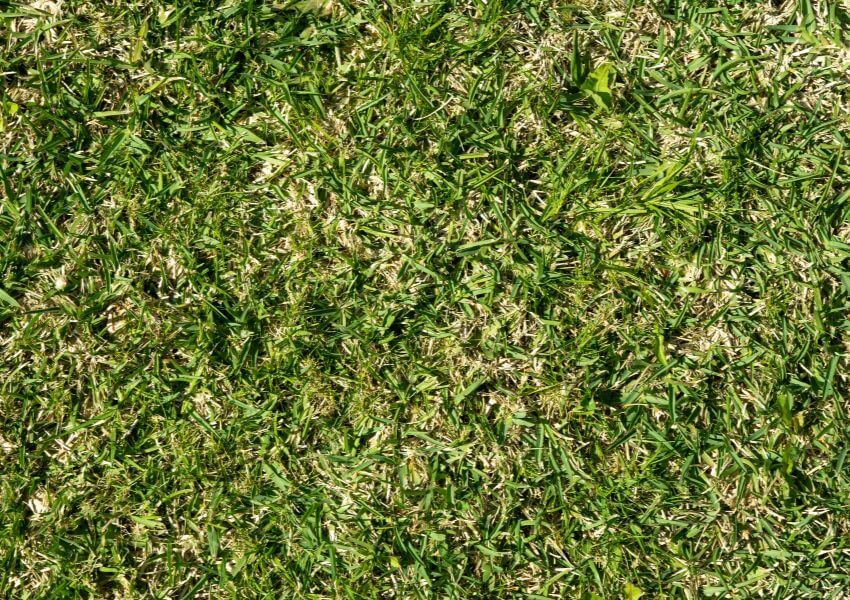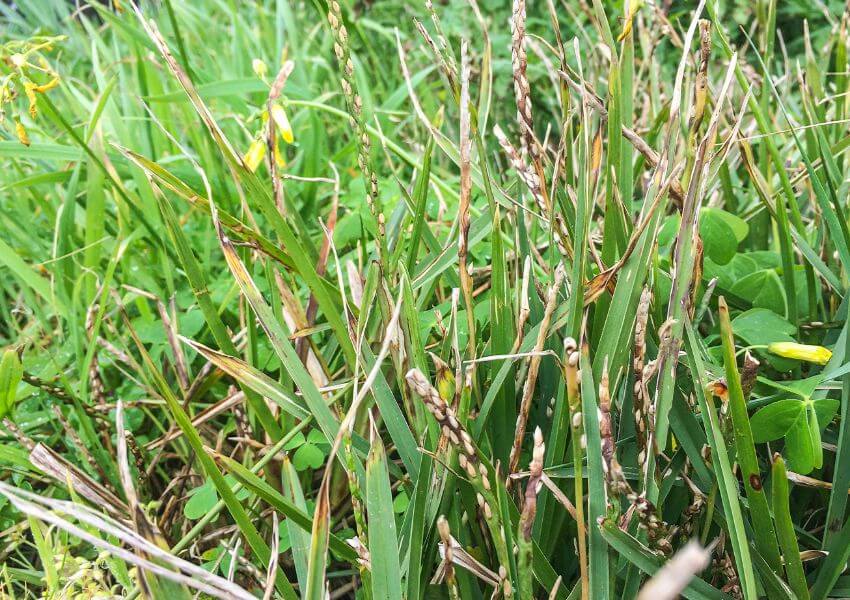Embarking on a journey to cultivate a lush, vibrant lawn leads many homeowners to ask, “How to make St. Augustine grass thicker?” This comprehensive guide addresses this query, diving into the nuances of nurturing St. Augustine grass, a popular choice in the southern United States.
Known for its resilience and appealing appearance, achieving a thicker St. Augustine lawn involves a series of targeted steps.
From selecting the right fertilizers to mastering the art of watering, mowing, and soil care, this guide provides insights into each crucial aspect.
Whether you’re an experienced gardener or a novice, these tips and techniques will equip you with the knowledge to transform your St. Augustine grass into a denser, healthier lawn.
The St. Augustine Grass
St. Augustine grass is a robust, warm-season turfgrass favored in the southern United States, particularly across the Gulf Coast from Florida to Texas.
Originating in Saint Augustine, Florida, and introduced in the early 1800s, it has since become a prevalent choice for lawns and gardens in the South due to its hardiness and adaptability to various conditions.
Known for its resilience, St. Augustine grass thrives in warm climates and is a staple in many Southern yards, owing to its ability to withstand diverse environmental challenges. This popularity has solidified its status as one of the region’s most sought-after turfgrasses.
Characteristic Of St. Augustine Grass
St. Augustine grass, renowned for its lush blue-green hue and dense growth, is a preferred turfgrass in warm climates, thriving in temperatures of 75 to 95 degrees Fahrenheit.
Predominantly found in the coastal areas of the southeastern United States, it’s widely used in pastures, ranches, and residential lawns.
Characterized by large, flat stems and broad, coarse leaves, similar to centipede grass, it propagates through stolons or surface runners, creating a thick, deep turf.
This growth habit enables it to effectively suppress weeds, making it a low-maintenance choice for lawns.
However, it’s vulnerable to cold weather and struggles in shaded areas, making it less suitable for regions with cool winters or heavily shaded landscapes.
Further information about this grass can be found through the University of Florida’s resources.
Growth of St. Augustine Grass
To establish a St. Augustine grass lawn, plugs are commonly used. They offer a speedy solution to cover bare spots in the lawn.
After planting, these plugs begin to spread, typically taking 7 to 14 days to start filling in gaps.
However, the development of a strong root system, crucial for stabilizing these plugs, requires time. During the initial weeks, these newly planted plugs demand frequent watering to ensure proper establishment.
With adequate care and a bit of patience, these efforts lead to the growth of a vibrant, green St. Augustine grass lawn, showcasing its full potential in both coverage and aesthetic appeal.

The Top 10 Ways to Thicken Your St. Augustine Grass
We’ll go over the top seven ways to thicken your St. Augustine grass below:
Fertilize regularly
Regular fertilization is key to enhancing the growth and thickness of your lawn. To achieve optimal results, it’s important to select a fertilizer formulated specifically for St. Augustine grass.
Adhering to the application instructions and recommended rates on the fertilizer package is crucial.
Over-fertilizing can be detrimental, potentially harming or even killing the grass. By following these guidelines, you can effectively nourish your lawn, encouraging healthier, denser grass growth.
Water deeply and less often.
Watering your lawn deeply yet infrequently is beneficial for promoting robust root development, leading to a denser and healthier grass cover.
It is most effective to water early in the morning. This timing allows the grass to dry before evening, reducing the risk of fungal diseases that flourish in moist conditions.
Such a watering approach not only strengthens your lawn but also helps in maintaining its health by preventing common grass ailments.
Mow high
Avoid cutting your lawn too short, as this can harm the grass and increase its vulnerability to diseases.
For St. Augustine grass, it’s recommended to mow at a height of 2-3 inches. Maintaining this height helps the grass develop a deeper root system, which enhances its drought resistance and reduces the likelihood of disease.
Proper mowing height is crucial for the overall health and resilience of your St. Augustine lawn, ensuring it remains lush and robust.
Remove Thatch
Thatch, a layer of dead grass and organic material on the soil’s surface, can impede water and nutrient absorption if it becomes too thick.
Regularly removing thatch is important to maintain a healthy lawn. Use a garden rake or a specialized thatching rake to break up and clear away this layer.
This process ensures that water and nutrients can effectively reach the grass roots.
Additionally, if you notice your grass is deteriorating, it’s crucial to diagnose and address the underlying issues to rejuvenate your lawn.
Aerate the soil
Soil aeration is essential for a healthy lawn, as it enhances drainage and facilitates the penetration of water and nutrients to the grass roots.
This process also alleviates soil compaction, which can harm root growth. For effective results, it’s advisable to aerate your lawn during spring or fall.
These seasons are ideal because they allow the grass to recover and thrive post-aeration, ensuring the roots receive the necessary elements for optimal growth and health.
Overseed your lawn
Overseeding is an effective technique for enhancing the density of your lawn. When overseeding, it’s important to choose a seed variety that’s specifically suited for St. Augustine grass.
The process involves evenly distributing the seeds over the soil’s surface. After seeding, continue with your regular watering routine to encourage germination and growth.
This method not only thickens the lawn but also revitalizes its overall appearance, ensuring a lush, healthy grass cover.
Resod the lawn
If your lawn is in poor condition, resodding may be the solution. Although more costly, resodding can quickly transform your yard into a lush, healthy space.
For optimal outcomes, choose St. Augustine grass sod. This type of sod can rejuvenate your lawn, offering immediate visual improvement and density.
Additionally, there are ways to enhance the greenness of your new sod, contributing to an even more vibrant and inviting outdoor area.
Resodding is a significant investment in the health and appearance of your lawn.
Soil Testing
Conducting a soil test is a wise step, particularly when you’re uncertain about your grass type.
A soil test reveals the pH level and nutrient deficiencies of your soil.
This knowledge is crucial as it guides you in selecting the most appropriate fertilizer for your lawn.
Understanding your soil’s specific needs ensures you provide the right balance of nutrients, promoting healthier grass growth.
A soil test empowers you to tailor your lawn care strategy for optimal results, ensuring your grass thrives.
Follow a lawn care schedule.
Adhering to a consistent lawn care routine is essential for cultivating thick, healthy St. Augustine grass.
Key practices such as regular fertilization, appropriate watering, mowing at the right height, and periodic aeration are crucial components of this schedule.
Establishing and maintaining a structured lawn care plan ensures your grass receives the necessary care at the right intervals.
This approach not only promotes the vitality and thickness of your lawn but also contributes to its overall well-being and aesthetic appeal.
Hire a professional
If thickening your St. Augustine grass seems daunting or time-consuming, consider enlisting a professional lawn care service.
These experts can accurately assess your lawn’s condition, identify any issues, and suggest effective solutions.
They’re equipped to handle all essential tasks, from fertilizing and watering to aerating, ensuring your grass achieves the desired thickness and health.
A professional’s expertise can be invaluable, saving you time and effort while delivering optimal results for your lawn.
Maintaining The Growth of St. Augustine Grass
Caring for St. Augustine grass is more straightforward than it might appear.
This grass thrives in moist and shaded environments, so ensuring these conditions can significantly enhance the appearance of your lawn.
By diligently following the outlined steps, you can cultivate an ideal St. Augustine grass lawn. Although it requires some patience and time, the effort pays off with a lush, healthy, and visually appealing lawn.
Commitment to these care practices is key to achieving and maintaining the beauty and health of your St. Augustine grass.It will take time, but it will be worth it when you do this.
Conclusion
In conclusion, mastering “how to make St. Augustine grass thicker” requires a blend of dedication, knowledge, and appropriate lawn care practices.
This guide offers a holistic approach, covering everything from the initial soil testing to the regular maintenance tasks like fertilization, watering, mowing, and aeration.
By following these guidelines, homeowners can foster a St. Augustine lawn that not only thrives but also enhances the overall aesthetic of their outdoor space.
Remember, patience and consistency are key; with time and effort, your St. Augustine grass can reach its full potential, offering a lush, green, and thick turf that is both beautiful and functional.

